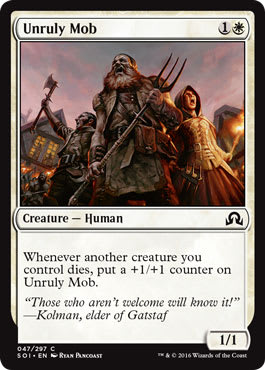Every type of design is about crafting an experience. In Magic circles, we talk a lot about divides between design and development or flavor and mechanics, but ultimately, all of the pieces come together in the finished product that players find in booster packs. So, while it may be simpler to pick out whatever seems to be important and optimize it, neglecting the broader experience is a disservice to the people you’re designing for.
Tradeoffs
In his initial design, Richard Garfield sacrificed mechanical elegance for flavorful resonance, but at some point, the people in R&D realized that the game is more fun when the mechanics function intuitively, and they turned away from a flavorful interpretation. For much of Magic’s history, mechanical design came first, and flavor played second fiddle, but things got a reboot with Magic 2010. Now R&D works to ensure that previously disparate pieces fit together without sacrificing too much in any one area. For instance, Innistrad is filled with top-down horror tropes, but they don’t read like Alpha’s fantasy versions.
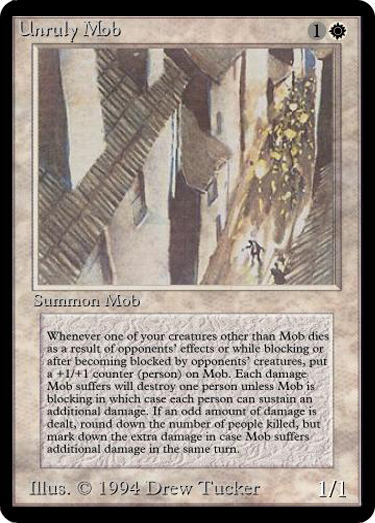 |
We run into analogous situations in terms of balance and sexiness, as Tom LaPille demonstrated using Silent Departure as an example. While the team went for play value with this Limited tempo spell, disappointing experiences such as when casting Radiate are a result of things going a bit too far the other way.
Killing Your Babies
While Development decides what does or doesn’t get to look exciting, there’s some question as to what will show up in the first place. Mark Rosewater has mentioned repeatedly how often he has to cut a great card design from the file because it just doesn’t fill the niche it needs to in a given set. It’s hard to dump cards by the wayside with nothing but the hope that they’ll fit somewhere soon to sustain you, but that process isn’t unique to the design team; Creative spent months crafting Innistrad as a perfect horror setting, and then Design came along and found the “perfect” reprint in the form of Blazing Torch . . . only Innistrad’s Vampires weren’t supposed to be flammable. They weren’t about to leave out this seamless inclusion on that basis, so Creative had to suck it up and degrade their world building in favor a better overall experience.
Changing Places
Seeing as most of us don’t work in the halls of Wizards of the Coast, we usually don’t have the opportunity to have separate design, development, creative, and marketing teams. Heck, we’re happy if we can find a few other people to help out at any point in the process. That means that it’s very easy for us to fall into the trap of assuming that in a real design, somebody else would deal with problems. If a card seems really strong, we can’t immediately write it off as a development issue and continue on our merry way. Just look at undying—it took some pretty clever development to balance it in both Constructed and Limited without making unappealing-looking cards, but ignoring the issue could easily result in you having a mechanic that can’t both be balanced and look exciting and without enough time to explore another route.
It falls on each of our shoulders to take on every role we can. Not only do we want to make cards, sets, and blocks that could really exist, but for those who are like I am and who hope to work in R&D, understanding how the broader design fits together is the most unique and useful skill we can bring to the table.
Meanwhile on Kegree
Exploring design philosophy is all well and good, but let’s take a look at some application. In the course of exploring Kegree, we’ve already seen that the world and mechanics influence one another, and both pieces have shifted numerous times. There’s no reason that we couldn’t continue to explore our current setting, but a few days after last week’s installment went up, Wobbles introduced a groundbreaking idea (on the order of double-faced cards) in the comments:

We spent a while discussing the precise mechanical implementation and have yet to come to a consensus, but regardless of the exact wording, the ramifications for world building are clear.
You are entering the fray.
What would drive planeswalkers into personal combat? Wobbles proposed that players are trapped on this plane and vying for supremacy so that they might find a means of escape, but to me, planeswalkers’ personal involvement implies desperation. Gideon Jura fights because has no other way to stop the Eldrazi from destroying everything in sight, and Garruk Relentless is hell-bent on tracking down a certain veiled necromancer; neither one has time for the formalities of a planeswalker’s duel.
Forcing Their Hands
The whole Time Spiral neo-’walker reboot came about because Magic has historically had trouble using planeswalkers as protagonists. Not only is it hard to relate to somebody with limitless power, but as soon as the character got into trouble, he or she would simply go elsewhere. In my mind, that’s a great reason to trap ’walkers on a plane, but they need something more to force them into physical combat.
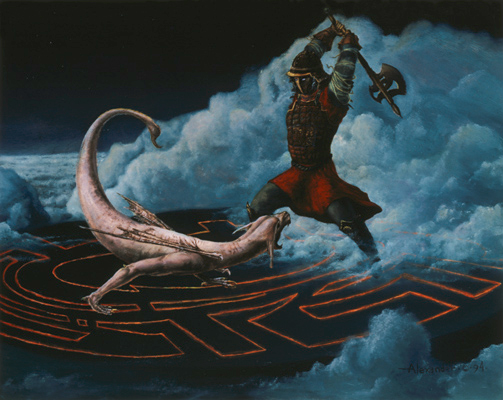
The entire plane of Arceum is one giant arena on which a group of incredibly powerful planeswalkers has trapped every other ’walker whom they can fool into entering. Word has come down from on high: Only if you best every other being here in combat will you be allowed to leave.
With this gladiatorial setting, players have the chance to fight one another directly, and because having players take damage on every turn (from attacking and blocking) should make for fast-paced games, chump-blocking should give them plenty of opportunities to crush creatures.
Development does offer some concerns—it will be hard for controlling strategies to battle both creatures and Auras without opening themselves up to drawing the wrong half of their deck, but that issue might be solvable with defenders such as Plumeveil. If that method works, it will be a culmination of recent work to bring creature combat to the heart of gameplay—er, player combat, too, I guess.
What Are We Up Against?
Our hosts are sure to have left some nasty surprises for their contestants to distract them from killing one another. The arena setting immediately led me to Greco-Roman mythology, and it seems to be a good setting for fights to the death to be subject to the whims of deeply flawed gods.
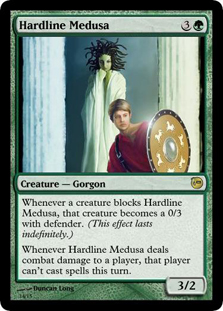
Thankfully, Minotaurs in labyrinths and Harpies stealing scant resources seem to be in line with the block’s motif, and while another setting might serve equally well, this one will probably be the most resonant for Magic’s predominantly North American player base.
When working with such base material, it’s easy to be caught up in all of the background to explore, but unlike with Innistrad, not every permutation supports the set’s design. The players should feel like they are gladiators battling for freedom, and tales of spats between the gods are unlikely to evoke that. Supporting the set’s focus flavorfully is great, but equally important is building it into gameplay. Gladiator battles consist of circling and engaging, and from a development standpoint, we can engender that cadence by concentrating powerful plays in a given mana range. That way, there will be a definite jump in action after some initial sparring.
Other Mechanics
Another way to augment Magic’s natural buildup is to include beneficial triggers that key off something consistent. While pretty much nothing is more consistent than the upkeep step, we have a chance to heighten the surface-level gladiatorial experience by keying off you entering fights. There are a few approaches here; one is to go really parasitic and reward players for dealing damage by themselves, but if we were taking that approach, it’s probably better to reward players for both themselves and their creatures. It’s too easy to just deal some damage, so in order to make things difficult enough to warrant some reasonable reward, I’d want these abilities to trigger either on blocking or becoming blocked. If there are a bunch of blocking triggers but no attacking triggers, players will be discouraged from attacking, so we could just have “becomes blocked” triggers . . .
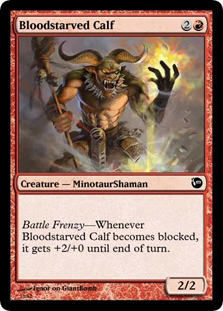
. . . or we could use this as the perfect opportunity to give bushido a reboot:
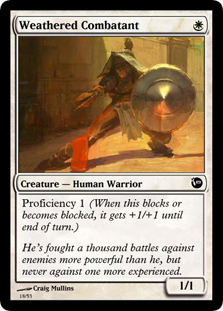
The one issue with proficiency is that in the second set, we’d most likely want to evolve the combat mechanic onto Aspects, and players don’t have toughness. We could give players +X/+0 and have them gain X life, but at that point, I’m not sure it’s even worth mirroring.
Cleaning House
We can’t simulate the entire life cycle of a Magic: The Gathering set outside the walls of Wizards, but I hope this week’s journey into the interdependencies of design was informative. Writing to a design-minded audience is tough because people come to the subject from such different levels of experience, so please let me know how this article was for you so that I can aim more precisely in the future.
In the meantime, I’d love to hear your thoughts both about this design and the process in general, and we’ll be back with something new next week.
Jules Robins
[poll id="142"]
















